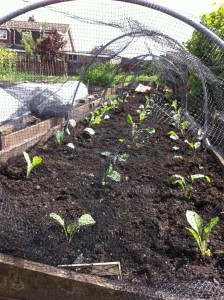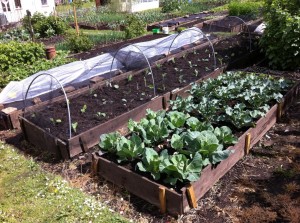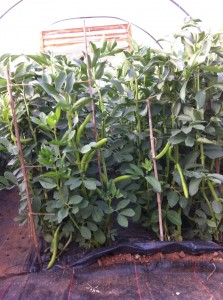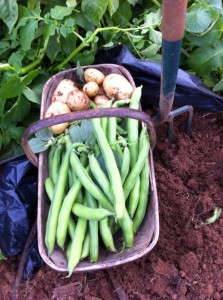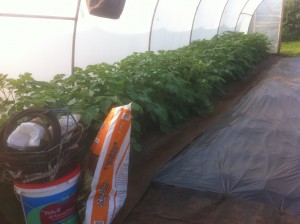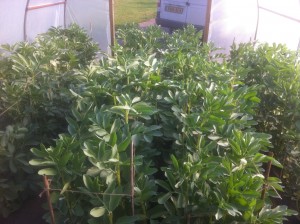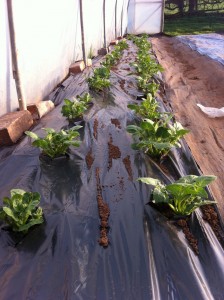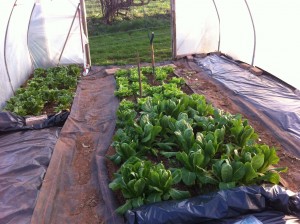Last week I was busy sowing seeds and making videos at the same time. Today I have uploaded six – there is another to follow soon. You can find them on the video page and also on the relevant pages on the’How to Grow Vegetables’ menu. I really hope you find these films about sowing seeds of tomatoes, peppers and chillies, onions, broad beans, cabbages, cauliflowers and broccoli useful. I have also included a very compact tour of my propagator and a peep inside my seed bank.
SERIOUS SEED SOWING
As we enter the last week of January I get very itchy fingers and the urge to sow becomes all consuming. So today I set the thermostat in the propagator in my greenhouse to 24 degrees, mixed a load of seed compost (3 parts John Innes soilless seed compost with one part low peat multi-purpose), selected my seeds, prepared some trays, loo-rolls and root-trainers and got to work.
This year I will be growing fewer new varieties of tomato and capsicum, concentrating on some old favourites and grwoing for fresh supplies of seed. So, I sowed into four inch pots a sprinkling each of these tomatoes; Nello’s Plum, an heirloom Italian tomato from Tuscany; Washington Cottage, an escapee from a US research centre which yields an abundance of small super-sweet fruit; Sungold, a popular yellow and very sweet cherry tomato; Small Red Pear, a gift from an HSL seed guardian which produces bunches of long trusses of tiny fruit and a local variety of Syrian indertimante that I am intrigued to see how it will turn out.
I sowed eight varieties of capsicum – Ukraine, one of my favourie discoveries which I have been growing for the last 25 years, having discovered this hot, sweet, three-lobed pepper in a market in Donetsk. This year I am growing from seed saved in 2003 inorder to refresh the supply; a long Syrian chilli from a local seed supplier – Future Seeds – simply called Flefleh; another sweet pepper with a rugged shape simply called Flefleh Helweh; a hot sweet small pepper from Syria given to me by a local farmer; a small sweet pepper from Tobago, originally collected by my dentist’s husband; Pasilla Bajo, a south American hot sweet paprika type which is a deep chocolate colour and one of my favourite sweet chilli peppers I found many years ago in the Moroccan desert I simply call Morocco.
I also sowed some Up to Date onion seed that I had saved in 2010 and a very exciting broad bean I found in a market in Damascus. These I sowed individuallu into loo-roll centres and put onto teh greenhouse floor. I call it mini because it is grown specifically to be eaten as an immature bean pod. I ate this bean many times when I was in Syria in March 2011 and found them utterly delicious. Finally I sowed in root trainers two varieties of early summer cabbage, Greyhound and an F1 variety Sherwood, which I am trying for the first time from D.T. Brown. I also sowed the cauliflower All The Year round and the magnificent perpetually flowering hybrid broccoli Olympia.
It was a busy day today because I also recorded a number of videos which I hope to have on the site in the next few days.
A NEW YEAR FULL OF HOPES, DREAMS AND PLENTY OF PRODUCE
Today I couldn’t wait any longer. I had to start sowing. Too early for outside but with one of my polytunnels now empty after completing harvesting new potatoes I had prepared a lovely series of seed beds a week ago, giving a light dressing of fish, blood and bone. In the warmth of a the polytunnel – it being another glorious, sunny day today – I sowed two varieties of carrot; an F1 early from Dobies called Parano and Amsterdam Forcing 3 Sprint from D.T. Brown. I also sowed two varieities of beetroot; Red Ace and Boltardy, both from the Organic Gardening Catalogue. Lettuce varieites were Winter Density from Mr Fothergill and Winter Lattughino, bio-dynamic seed I was given by the head gardener at my oldRudolph Steiner school, Michael Hall. I also broadcast a handfull of winter mixed salad leaf from Dobies and sowed too a short row of rocket from Franchi seeds and Scarlet Globe Radish from Garden organic. To be sure of lots of tsaty leaves in March and April I also sowed a short row of a spinach variety called Campania from Marshalls.
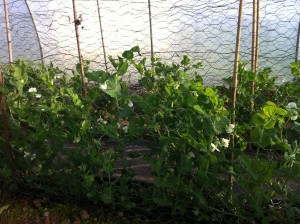 It’s been a very strange winter so far. On 7th October last year I sowed the pea variety Douce Provence in one of my polytunnels. Normally I would expect this variety to grow through the winter to no more than six inches. However, I have a crop now at least a foot hight, if not taller and coming into flower. In fact the first flowers appeared before Christmas. I will be fascinated to see if the crop will set properly if temperatures remain low – already the first flowers have set – and maybe I’ll be eating peas before Easter.
It’s been a very strange winter so far. On 7th October last year I sowed the pea variety Douce Provence in one of my polytunnels. Normally I would expect this variety to grow through the winter to no more than six inches. However, I have a crop now at least a foot hight, if not taller and coming into flower. In fact the first flowers appeared before Christmas. I will be fascinated to see if the crop will set properly if temperatures remain low – already the first flowers have set – and maybe I’ll be eating peas before Easter.
Although I do keep a minimum temperature in my greenhouse I have not expected to still have chillies ripening. However, Pubescens Rocoto, a black-seeded variety is still gowing strong. Very hot and pungent, I expect to keep harvesting through to the end of February!
LATE SUMMER AND MUCH WORK
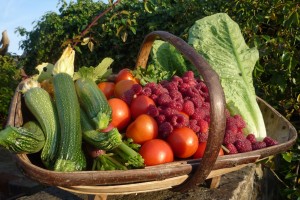 The last couple of months have been busy tending, harvesting and sowing for winter. It is now that one realises the long row of runner beans sown with enthusiasm in May is yielding enough to feed the 5,000. Remember the glut now and which will continue until the frosts kill the plants. A little of lots of different vegetables is more satisfying than a lot of just a few varieties. At this time of year I start to collect and clean seed for myself, for other seed collectors and for the Heritage Seed library.
The last couple of months have been busy tending, harvesting and sowing for winter. It is now that one realises the long row of runner beans sown with enthusiasm in May is yielding enough to feed the 5,000. Remember the glut now and which will continue until the frosts kill the plants. A little of lots of different vegetables is more satisfying than a lot of just a few varieties. At this time of year I start to collect and clean seed for myself, for other seed collectors and for the Heritage Seed library. 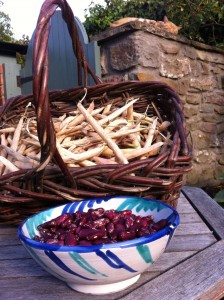 Please check out the website seed saving section to see what I do and how you too can save your own seed to grow next year.
Please check out the website seed saving section to see what I do and how you too can save your own seed to grow next year.
It may be the middle of August but it is not too late to be sowing now for crops later this autumn and into the winter. If you haven’t sown spring cabbage or Kale get started now. I like spring cabbage like Advantage, but the best stuff for those mid-winter meals and good spring greens is kale. My absolute favourite is Asparagus Kale and I have a good supply of fresh seed just harvested. So long as you are able to transplant your brassicas by then end of September you will get a good crop come springtime. Start off seed in pots or root trainers in regular John Innes seed compost. Keep well watered and also protect seedlings from attack by cabbage white butterflies using a screen of enviromesh or fleece which is obtainable from any half-decent garden center.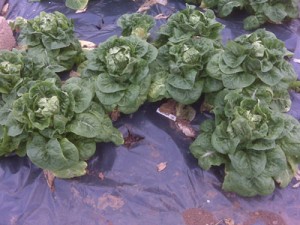
Overwintering lettuce can also be sown now. Winter Density is a very reliable cos-type which if sown outside now can be thinned or transplanted in September either under a sturdy cloche or into the greenhouse border. Large pots in a greenhouse are also good for growing on your lettuce. Allow four plants to a 12-inch pot of good multi-purpose compost. I like to add some dried blood when transplanting to encourage leafy growth. This is especially important early in the new year if you want crisp tasty lettuce for Valentine’s day and before! Other very reliable winter lettuce worth a go are Valdor and the best cos of the lot, Lobjoits Green Cos.
Rocket, Mizuna and many Chinese greens can be sown now for harvesting up until Christmas and beyond if the weather is clement.
MIDSUMMER WONDERFULNESS
The spring may have been hot and dry, but June has changed all that. Cool and wet. The chilly nights haven’t slowed down the rate of growth however and the much-needed rain has come just at the right time for peas and beans which need polnety of water if they are to provide good crops.
After a very slow start and considerable problems from sparrows eating the growing tips, my peas are finally getting into their stride. Early crops sown in March are in full flower and I did eat the first peas yesterday – straight from the pod. My trial of Kew Blue are finally climbing but I fear they may not reach their full potential even though the plants of eight seeds I sowed are flowering quite freely.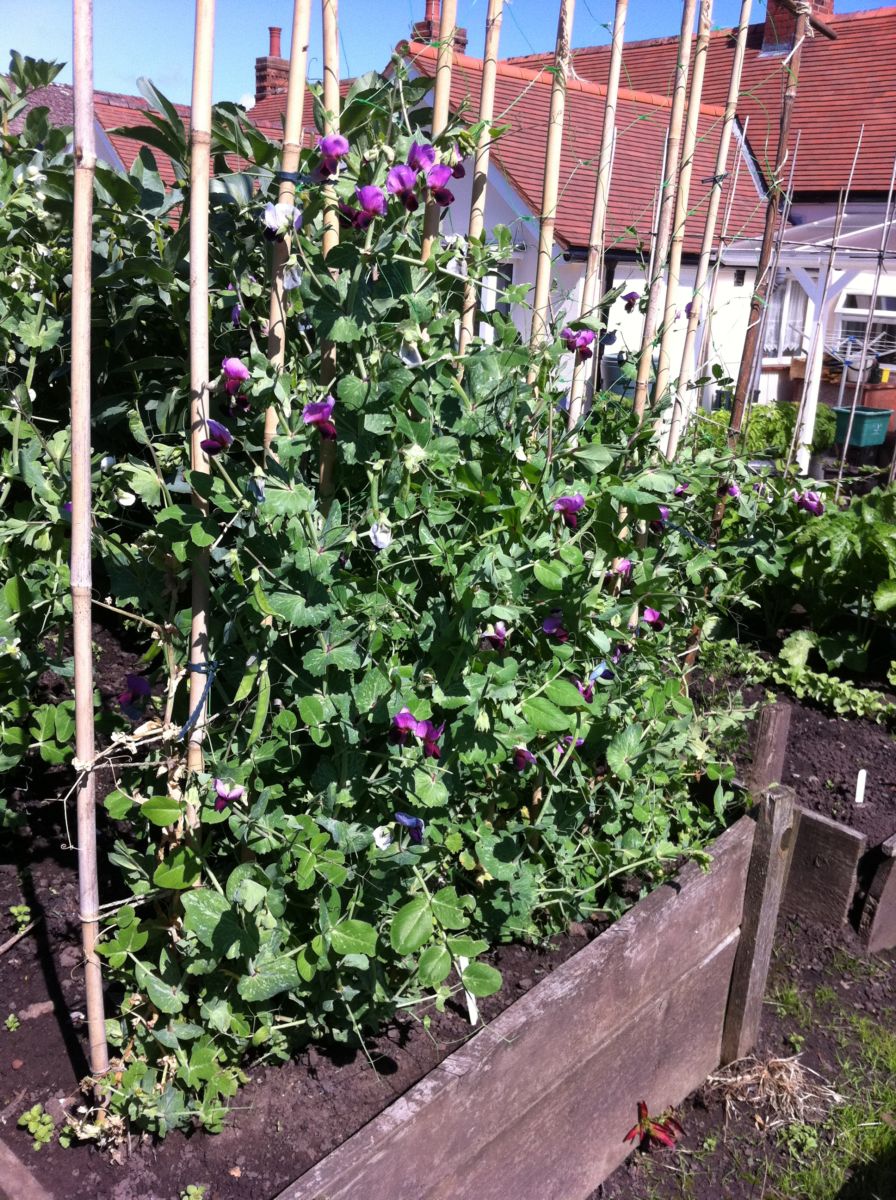
TRANSPLANTING CABBAGES AND COURGETTES, HARVESTING BEANS AND SPUDS
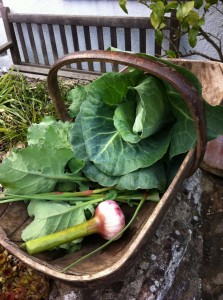
Tundra cabbage, the flowering tops of Delaway winter kale, the first young garlic and a few garlic scrapes will make a wonderful stir-fry
It’s the middle of May and the last couple of weeks have been very busy, catching up with planting, transplanting and sowing. The brassicas I sowed in late March needed to be transplanted into their riased beds. I noticed that the dreaded Small Cabbage wWhite is around and found a few clusters of their yellow eggs on the underside of some of the leaves, so I decided to cover immediately with a fine mesh to protect the crop.
The cabbage and broccoli I transplanted back in March are growing on well and should be ready for eating in the next few weeks.
This very dry spring has been a challenge. Not only do salad crops need lots of water, so do peas and carrots Yesterday I installed a trcikle irrigation system on a couple of my raised beds and over several hours emptied a large water butt onto them. You can see the system at work in this photo. Highly recommended I say. I bought enough tubing and connectors to irrigate 6 of my beds at any one time for just £29. It’s worth checking out www.watermate.co.uk
I am a passionate advocate of polytunnels. They extend the growing season dramatically. Having had problems with overwintering broad beans suffering recent very cold winters I sowed Aquadulce in a polytunnel last November and am now able to harvest a good crop of lovely beans. With my second lot of early potatoes, the delicious variety Accord, now eating well another feast tonight is in order
As well as transplanting cabbages last week I have also transplanted one of the tastiest squash I know, Pompeon, into one of my polytunnels. I am growing aa American heirloom Armenian cucumber too. I planted four rather straggly plants, two-feet apart in the greenhouse on the allotment and plan to train them up canes and along wires. I also planted a couple of melon called Sugar Baby with which I have had some success in the past.
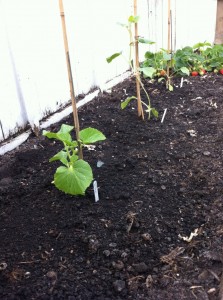
Young Armenian cucumbers with ripening strawberries on 15th MaySyrian courgettes transplanted on 8th May under bell cloches
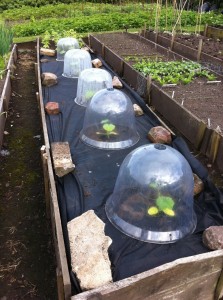
Seed hunting in Syria and catching up at Easter
I recently returned from nearly three weeks travelling in Jordan and Syria. Although my principal reason for the trip was to visit ruins and walk in the mountains and desert, I didn’t need any excuses not to go in search of vegetable seeds.
Syria was especially interesting. The country grows a huge amount of food and at this time of year the fields in the fertile valleys and in the terraced hills and mountains are full of crops of cucumbers, courgettes, tomatoes, egg plant, cabbages, salad crops and young wheat, flowering apple trees, cherry blossom everywhere and pistachio, fig, almond and apricot trees all coming into growth. Olives are grown at every elevation from mountain terrace to desert plain.
The cucumbers and courgettes are especially interesting as Syrians eat their cucumbers now when they are no more than about 12 cms long. They breed a particular variety to eat very young. Their courgettes are interesting too. Although they do grow American hybrid varieties including one called Babylon, some farmers also grow a native type which has a lower water content than the courgettes we are used to eating. These little Syrian beauties are firm, flavoursome and I found a refreshing alternative to the rather dull vegetable we usually grow.
I visited a food market in Aleppo and found two stalls selling vegetable seed, all locally grown. As soon as I got home on 19th April I sowed two varieties of courgette, one produced by a company called ocal Seed(!) and another which came loose from a horticultural supplier. I also sowed a local variety of mini-cucumber. Today, Easter Sunday 24th April and everything has germinated. Very exciting.
In both Jordan and Syria they like to eat young broad beans, chopped up and blanched before mixing with olive oil. This dish is a great delicacy and I was keen to find some local seed. In Damascus in the old souk I found a horticultural supplier who had sacks of seed. The bean is very small and the pods quite short and variable. I plan to sow some tomorrow. Fava beans are also popular and I ate them in a rich, creamy sauce flavoured with cumin. I was able to buy about 100 grams of this seed too. So it will be interesting to see how they grow although I am tempted to wait until next year to sow some as I want a long growing season to ensure I get a good crop of dried Fava, (broad) bean.
In both Damascus and Aleppo I found some interesting sweet peppers and some mild, large chillies. In this part of the world the locals do not eat very spicy food. Again, the seed I found in the market will have to wait until 2012 until I try to grow them.
Now, back home, I have been catching up with my veggie plans. Capsicums and the last of the tomato plants have been planted into the poly tunnels. A major weed on the allotment, sowing of roots and salad crops, transplanting under cloches of beans, sowing more peas, runner beans and French beans continues. Hopefully, with a dry Easter Monday I will be fully up to date.
It is a joy to have polytunnels. My early crop of the potato Rocket is in flower and I scrabbled around a few plants to see how the tubers are doing. There is certainly a meal now so this week i will be eating my first potatoes of 2011. The broad beans I sowed in another polytunnel are doing very well. Although, not the mos prolific flowers, Aquadulce gives a good crop and I have had a very good flower set. Today there are many pods, just a couple of inches long, starting to fill. I’ll be eating whole juvenile beans on May Day!
GETTING THE MOST FROM A PACKET OF SEEDS
The last few days have been hectic and very rewarding. Now is one of the sweetest times for a vegaholic as we can see spring is well on her way, the ground is warming up and there are a whole host of seeds to sow, plants to pot up, pot on and put out.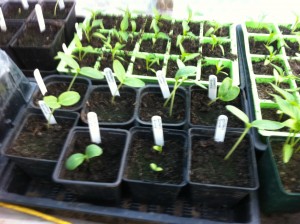
BUYING SEEDS: Although I save seed of about half of all the vegetables I grow, there are many, like roots and salad crops and especially hybrid seeds which I buy. I am enraged at the cost of seed in the UK. Compare a packet of seed from any of the main suppliers here with what you can buy from say the Italian seeds people Franchi and you might share my view. However, sowing just the right amount of seed means one can get best value from a packet and properly stored, most seed will remain viable for years.
SOWING SEEDS: By far the most expensive seeds are those of F1 hybrid varieties. Recently I bought a packet of broccoli seed called Olympia which contained just 24 seeds. I sowed 2 into twelve small pots and they all germinated, so I transplanted the duplicates into twelve more pots. I nly wanted twelve for my allotment so the other twelve are now in the hands of a couple of gardeners in the village. There are two lessons from this experience. Firstly, only sow enough seed to give you the quantity of plants you can comfortably eat as they come to maturity. Crops like broccoli, calabrese and cauliflowers are in thehabit of maturing all at thesame time. For me, even twelve of any variety is probably six too many. With just two mouths to feed most of the time I know that over a three or four-week cropping period I will only really want to heads of broccoli for example per week. The second lesson is to only sow one seed per pot of Olymia next time!
I am sure seed companies just love us to sow too thikly and too many and to buy fresh seeds every year. But a packet of lettuce seed which contains 300 seeds will give you, as near as damnit, 300 lettuce to eat. Sowing at monthly intervals through the season, maybe just a two-foot row of something like Little Gem means there are four or fiveto be left to grow on and maybe a dozen to transplant. the transplants will mature a few days later than those left in the ground. Sow the lettuce seed individually at one-inch (25mm) intervals. The two-foot row will yield up to 24 plants, so even with this method you will end up either giving a few seedlings away or chucking them on thecompost heap. But for a family of four, that packet of lettuce seed should last you at least two or three growing seasons. Small seeds like carrot should be sown as thinly as possible. certainly no more less half an inch (12mm) apart. Ditto radish, which can be thinned and eaten as you go. Beetroot is another vegetable that should be sown very thinly and in short rows. A 2-metre row will yield at least 40 beetroot and the seedlings can be transplanted when they have four true leaves. Parsnip are slow to germinate and require warm ground, so starting them under a cloche is a good diea. I put three seed at 6 inch (15cm) spacing and this out the two weakest seedlings. Parsnips can grow very large – see my intro video – so just how many does the average family need through the winter. I always grow too many – that is an five-metre row. But many are given away. If I was just to grow for Julia and myself then perhaps twent roots would be enough – a ten-foot (3 metre) row. Parsnip seed have a reputation for not storing well. This year I sowed the last of a packet of seed I bought in 2009and every seed germinated!
Soon it will be timeto sow beans of all sorts – Runner Beans, dwarf and climbing French beans. But how many to sow? Too often come August the world and her husband are giving away their gluts.Sensibly, a family of four can feast on 10-foot row of kidney beans and still have plenty for the freezer and to give away. I only grow a one-metre row of kidney beans, but beans for drying I want lots of so up to ten metres or more of Borlotto or Ryder’s Top of the Pole for me! Peas are another crop I can never have too much of. The siurplus end upin teh freezer for consumption as a winter treat.
KEEPING SEED SAFE: The best way to keep seed so they remain viable for several years is to store them in an airtight box or jars in the fridge.
Enjoy your gardening and see how much money you can save on seeds by a judicious use of this precious resource.
Entering the Golden days
At last, the euinox is just past and for the next six months the sun is in the sky for more than twelve hours a day. Yipee. Lovely early mornings beckon for time alone to sow, plant, hoe and harvest. And boy is it kicking off big-time right now.
Today was just blissful. Clear blue skies, a temperature of 18 degrees and plenty of time to work on the plot.
First up was to transplant a summer cabbage called Greyhound into a bed I had ready at the top of the garden. I had sown seed in root trainers in the greenhouse back in February. The plants have been hardening off in a cold frame for the last three weeks and were ready to go in the gound. Likewise I planted a broccoli called Olympia. A fiendeshly expensive hybrid we’ll see what it does but I got every seed in the packet to grow – 24 in total – so my neighbours are benefiting too. I also planted up a couple of short rows of Little Gem lettuce for good luck.
It was time too to get the last of my early spuds in the ground. Using my tried and tested method of planting through black-poly and covering with a cloche I now have twenty Nadine safely in the soil, and hopefully providing meals in June when the spuds in the polytunnel have all been eaten.
The crops in the polytunnels are doing well now we are having a decent warm spell of weather. I have been harvesting lettuce for some weeks but there are more than enough left to keep me and the neighbours in salad stuff until the frst of the outdoor crops come fit to eat later in April.
My overwintering Aquadulce broad beans are looking promising, the first flower buds are starting to form and I even noticed a solitary bumble bee buzzing hopefully in the tunnel – maybe she needs to wait another couple week for the first flowers to open!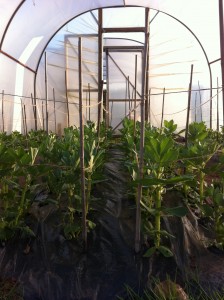
A dangerous time for impatient gardeners
It’s the end of the first week of March. The sun is shining and in my polytunnels and greenhouses the temperature is in the 80’s. But as darkness falls so does the thermometer! This time of year can be a dagerous period. Seduced by longer days and the need to get sowing we hope for the best and scatter our seed injudiciously. Caution is required.
Protected crops can forge ahead. Early potatoes in the polytunnel are already pocking their noses through the soil; broad beans are pushing skyward and lettuce are beginning to fill out. But unless your precious germinating seeds are protected by cloches they may refuse to grow and simply rot. If in doubt, wait a week or two. Later sowings will catch up. Better to prepare seed beds and finish getting the ground in perfect condition to get working later in the month.
Having said all that, I do risk the weather. Just a couple of days ago I transplanted into open ground some early summer cabbage that I had growing over the winter in pots in the greenhouse and more recently, hardening off in a cold frame. My garden greenhouse is absolutely chock-a-block with seedlings. I have started celeriac and fennel, more tomatoes for growing outside – the awesome Salt Spring Sunrise and an orphan from the HSL called Victory. Also early sweet-corn which I will plant in a polytunnel next month for a crop in July – the first of a succession of sowings of sweetcorn over the next two months. Also germinating on the greenhouse bench are various French beans and more cabbage, broccoli and calabrese need to be moved into a cold frame to harden off.
I need to make space because tomorrow I will transplant my peppers and chillies and start some squash going in the propagator. I am on my travels for a couple of weeks so needs must. Hopefully, when I return the greenhouse will be a mini-jungle, my early spuds will be green mounds of loveliness, my lettuce will be begging to be eaten – I did have one tonight for supper, (yum yum) – and my broad benas will have started to flower!
Us gardeners can but dream!


